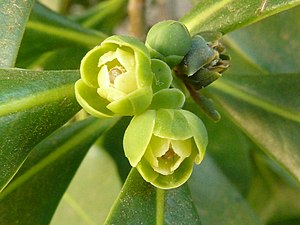Warburgia salutaris
| Warburgia salutaris | ||||||||||||
|---|---|---|---|---|---|---|---|---|---|---|---|---|

Warburgia salutaris |
||||||||||||
| Systematics | ||||||||||||
|
||||||||||||
| Scientific name | ||||||||||||
| Warburgia salutaris | ||||||||||||
| ( Bertol. ) Chiov. |
Warburgia salutaris (also known as the pepper bark tree because of the peppery taste of the bark ) is a species of the Canellaceae family . The generic name Warburgia honors the German botanist Otto Warburg (1859–1938); the Latin addition salutaris means 'healthy' in translation.
description
Warburgia salutaris grows as an evergreen deciduous tree that can reach heights of 5 to 10 meters or more. The brown, rough bark covered with many lenticels is bitter and peppery.
The alternate, simple, elliptical to lanceolate, dark green on the top and light green on the underside, short-stalked, leathery leaves are striking . The entire, obovate to lanceolate and bald leaves are pointed to acuminate. They are up to about 11 centimeters long, up to 3 centimeters wide and have a burning, bitter, aromatic taste. The stipules are missing.
In the leaf axils, the greenish and very small, hermaphrodite flowers stand together individually or on a short inflorescence stem in a zymous or racemose inflorescence . There are three leathery sepals and about 10 petals in two unequal circles, the outer ones are larger. The 10 stamens are fused and the anthers are free. The unilocular ovary is upper constant with short, thick pen and flat, capitate, feingelappter scar .
The round to egg-shaped, leathery, yellow-green to about 3 centimeters large, leathery berries take on an increasingly dark to purple color in the course of the ripening process.
Occurrence
Warburgia salutaris is native to the evergreen forest areas of the African continent (mainly in the northeastern part of South Africa ). The distribution area extends from Mozambique and Zimbabwe to KwaZulu-Natal .
use
Locals also call this tree Peeper Bark Tree , which means pepper-bark tree and describes the peppery taste of the rough, dark-brown bark. For ingestion, the bark is dried and pulverized and then pressed into balls.
The pepper tree is known by the residents as "Ishibaha", in German the healer , and is used for a wide variety of diseases. The reason for its great popularity is the wide range of active ingredients found in tree bark.
The best known active ingredient is certainly the tannic acid tannin , which is responsible for its traditional use in the treatment of malaria .
One of the antibacterial components of Warburgia salutaris is a sesquiterpene . The other active ingredients of the bark have strong fungicidal (effective against fungi) and antibacterial properties and make them a “green” antibiotic .
In particular, diseases of the respiratory tract , such as colds , dry coughs , bronchitis , asthma and pneumonia, are treated with it in African medicine.
She also finds in the treatment of gastric ulcers , headache and toothache , rheumatism , sexual disorders , cystitis , skin diseases , ulcers and eczema a permanent place in the African art of healing.
Since its properties became known, the tree has been on the Red List of Endangered Species . However , the situation has eased somewhat due to controlled cultivation in official plantations .
The leaves are used for seasoning or in teas.
literature
- Giles Mbambezeli: Warburgia salutaris on plantzafrica.com.
- C. Hilton-Taylor et al .: Warburgia salutaris in the IUCN Red List of Threatened Species . (English).
- Cailean Clarkson, Eliya V. Madikane, Steen Honoré Hansen, Peter J. Smith, Jerzy W. Jaroszewski: HPLC-SPE-NMR characterization of sesquiterpenes in an antimycobacterial fraction from Warburgia salutaris. In: Planta Medica . Vol. 73, No. 6, 2007, ISSN 0032-0943 , pp. 578-584, doi : 10.1055 / s-2007-967187 , PMID 17486536 .
- Vukani Eliya Madikane, Sanjib Bhakta, Angela J. Russell et al .: Inhibition of mycobacterial arylamine N-acetyltransferase contributes to anti-mycobacterial activity of Warburgia salutaris. In: Bioorganic & Medicinal Chemistry . Vol. 15, No. 10, 2007, ISSN 0968-0896 , pp. 3579-3586, doi : 10.1016 / j.bmc.2007.02.011 , PMID 17368035 .
- TE Clark, CC Appleton: The molluscicidal activity of Apodytes dimidiata E. Meyer ex Arn (Icacinaceae), Gardenia thunbergia Lf (Rubiaceae) and Warburgia salutaris (Bertol. F.) Chiov. (Cannelaceae), three South African plants. In: Journal of Ethnopharmacology . Vol. 56, 1997, pp. 15-30, doi : 10.1016 / S0378-8741 (96) 01496-1 , PMID 9147251 .
Web links
- Warburgia salutaris on treesa.org.
- Warburgia salutaris at Useful Tropical Plants.
Individual evidence
- ^ Warburgia salutaris at Heidelberg University.
- ^ Rafaël Govaerts (ed.): Warburgia. In: World Checklist of Selected Plant Families (WCSP) - The Board of Trustees of the Royal Botanic Gardens, Kew . Retrieved June 1, 2018.
- ↑ T. Rabe, J. van Staden: Isolation of an antibacterial sesquiterpenoid from Warburgia salutaris. In: Journal of Ethnopharmacology. Vol. 73, No. 1/2, 2000, pp. 171-174, doi : 10.1016 / S0378-8741 (00) 00293-2 , PMID 11025153 .
- ↑ Warburgia salutaris: The medicinal pepper tree from Africa ( Memento from September 5, 2012 in the web archive archive.today ).
